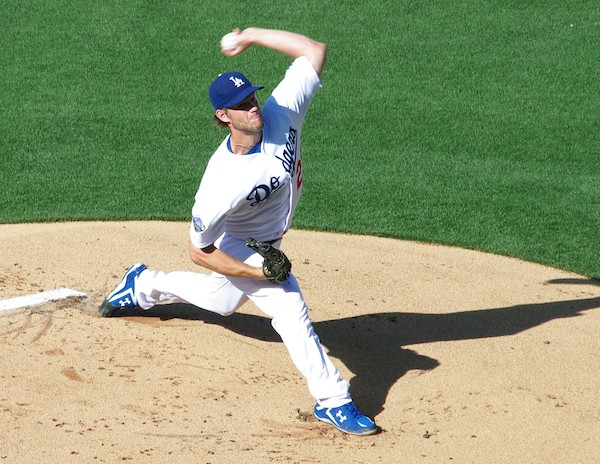Dear Sports Fan,
What different kinds of pitchers are there in baseball? It seems like a very specialized position. I keep hearing people label pitchers in all sorts of different ways, “junk pitchers, submariners, middle relievers,” but I don’t know what all the terms mean. Can you help?
Thanks,
Jan
Dear Jan,
There are a lot of different ways to describe a pitcher. “Junk pitcher, submariner, and middle reliever” are not only three different descriptions but they each describe a different class of description. “Junk pitcher” refers to the kinds of pitches a pitcher throws, “submariner” describes a pitcher’s throwing motion, and “middle reliever” describes when, during a game, a pitcher plays. One of the cool things about baseball is that none of this is rule based. All pitchers are the same according to baseball rules. It’s convention that defines how pitchers are classified. Let’s run through each category and look at the common descriptions and meanings together.
Pitchers classified by the pitches they throw
- Junk pitchers – Junk pitchers specialize in throwing slower (relatively slower — they might still throw up to 85 miles per hour) pitches that fool a batter by curving down or sliding sideways as they approach the base.
- Knuckleballers – A knuckleballer is an extreme version of a junk pitcher. These pitchers basically only throw one type of pitch — the knuckleball — which flies in such a tortured way that it’s often hard for the catcher to even catch it, much less a batter hit it. Because the pitch is thrown so slowly, these pitchers can have very long careers.
- Power pitchers – Also called fireballers or flamethrowers, these guys throw extremely hard. Nowadays, a good power pitcher can throw in the upper 90s or even 100 miles per hour. Their pitches may not move as much in the air but it’s extremely hard for batters to “catch up to them” before they’re in the catchers mitt.
Pitchers classified by throwing motion
- Sidewinders – Sidewinders throw the ball with a motion a little like a normal frisbee throw. Their arms stay around shoulder or chest level throughout their delivery. These pitchers are rare in American baseball but oddly common in Japanese baseball.
- Submariners – Submariners are a rare breed of pitcher that throws the ball with a motion that brings their hand almost down to the ground before releasing the ball. It’s a crazy looking thing but it’s often very effective, partially because throwing the ball this way makes it move in unusual ways as it approaches the plate.
- Normal pitchers – The vast majority of pitchers in Major League Baseball throw with the same overhand motion that most of us were taught to throw with as kids. They just do it with so much velocity that, if you watch them in slow motion, it looks like they’re going to rip their arms off their body from the strength of their throwing motion.
Pitchers classified by when they pitch
- Starters – Starters are expected to pitch for the first six innings of the game. They will often throw close to a hundred pitches before wearing down enough to be taken out of the game. Starters pitch only once every five days. That’s how harsh this job is on their bodies.
- Middle Relievers – Middle relievers take over for a starting pitcher who needs to be substituted before the eight inning. They’re the least valued members of the pitching staff but also often the most versatile.
- Closers – These pitchers come in to “close out” a game in the ninth inning when their team is ahead. They are specialists and most throw relatively few types of pitches. Often they are fireballers but once in a while, a very effective junk pitcher can excel in this role.
- Set–up men – Set-up men are a relatively new innovation. They’re specialists who come in just for the eight inning to “set-up” the closer. Think of them as the second best closer on the team. The Kansas City Royals have made a splash in the 2014 season by using two set-up men, one for the seventh inning and one for the eight. They may have just created the position of the set-up set-up man.
Pitchers classified by how they try to get batters out
- Ground ball pitchers – Ground ball pitchers aim to get batters to hit their pitches but to do it only under circumstances that the pitcher controls. Through placement, speed, and spin, the pitcher serves up only pitches that he thinks will result in an easily fielded ground ball.
- Fly ball pitchers – A fly ball pitcher, like a ground ball pitcher, pitches “to contact.” They don’t try to avoid having the batter hit the ball, they just manipulate the situation so that when a batter does get a hit, it flies harmlessly up in the air.
- Strike out pitchers – Strike out pitchers don’t want anything to do with the batter hitting the ball. They would much rather strike the batter out through deception or brute force or a mixture of the two than have them hit the ball into play.
These aren’t the only ways to describe a pitcher (he’s a bum/ace) but they are some of the most common ones. See if you can use one or more of these descriptions the next time you watch a baseball game.
Happy watching,
Ezra Fischer

